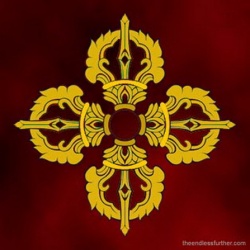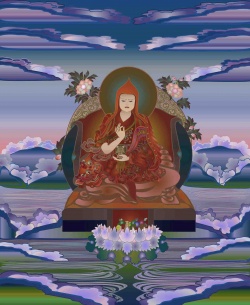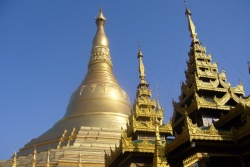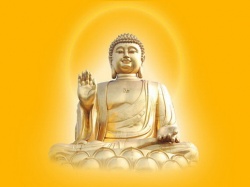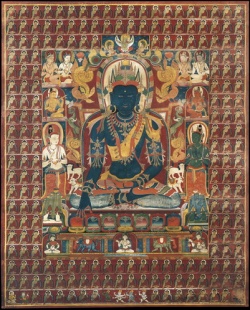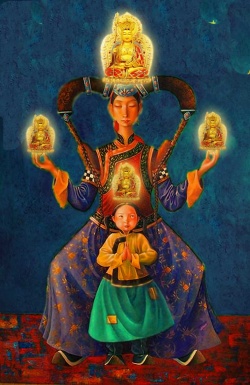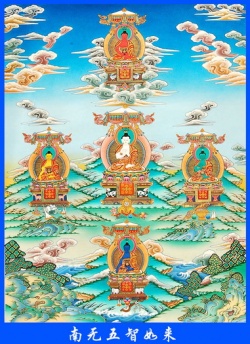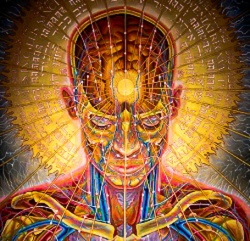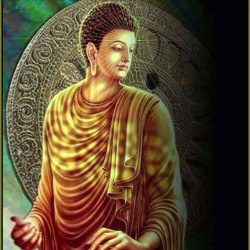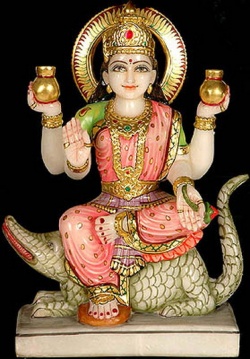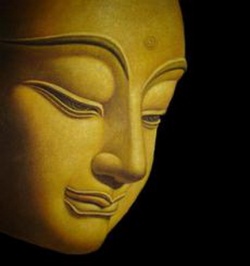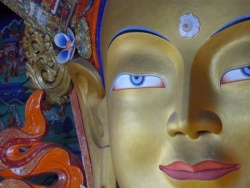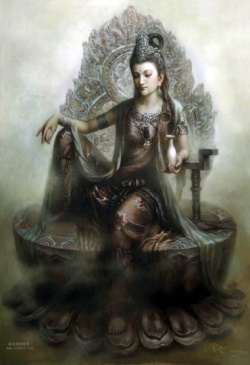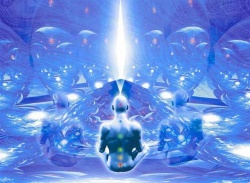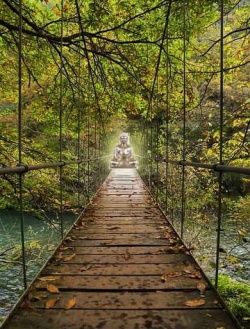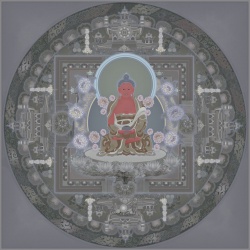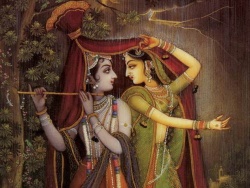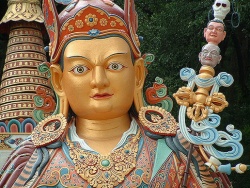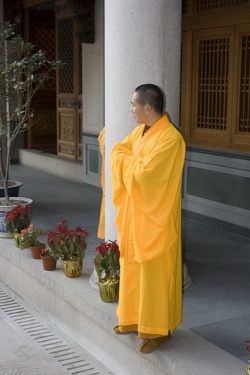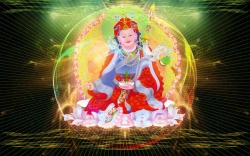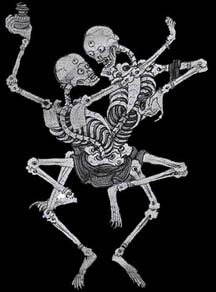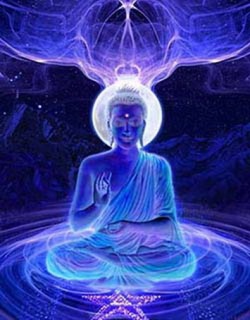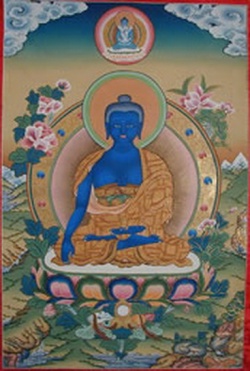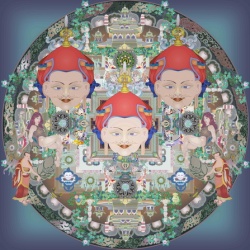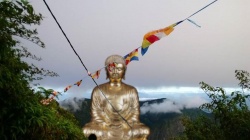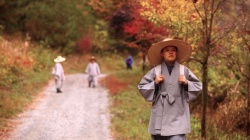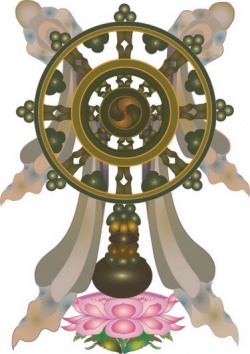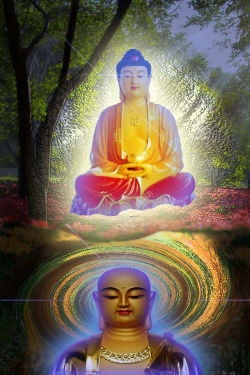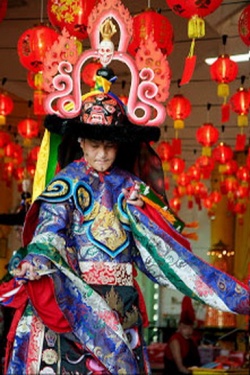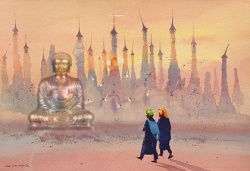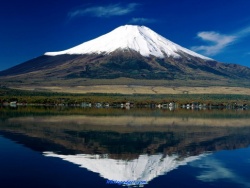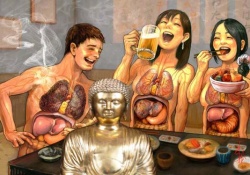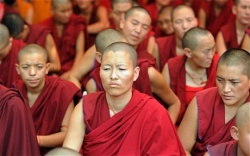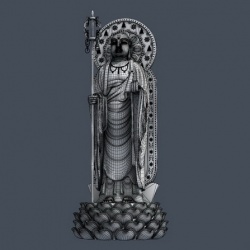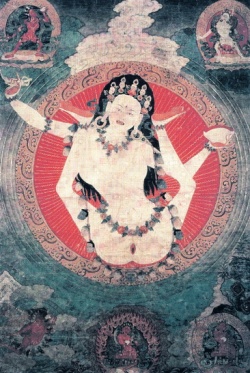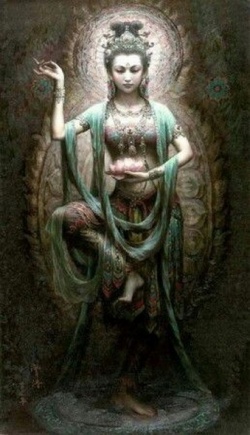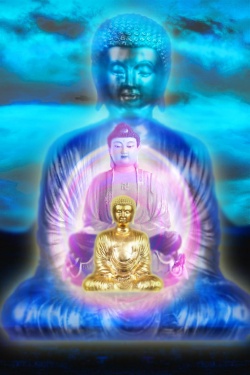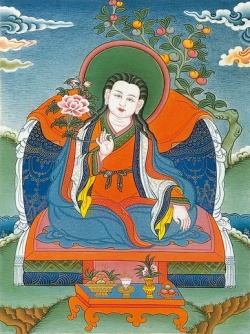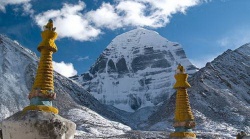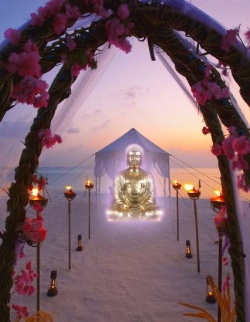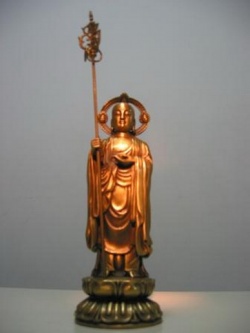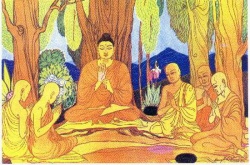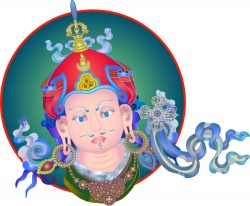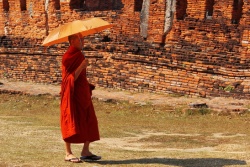Korean Buddhism and Art
The Buddha, his life and teachings, have been an inspiration to artists in many countries all through the ages. Korea is no exception. An appreciation of Korean culture is incomplete without an understanding of Buddhism's role in the development of the Korean arts.
For Korean Buddhist art is everywhere evident throughout the long history of the peninsula. Over half of the nation's 230 National Treasures are Buddhist: At least 37 statues, stone Buddhas and rock reliefs, 25 pagodas, 14 buildings, 15 stupas and lanterns, bells, several paintings and several copies of Sutras, including the huge set of the Tripitaka wood-blocks at Haein-sa Temple.
Nearly half of Korea's 848 officially designated treasures are Buddhist too. And the lists continue on through national, regional and local cultural properties; new discoveries are frequently being made. There would have been much more if it were not for the ravages of invasion and the greed of foreign collectors. Numerous works of Korean Buddhist art can be found in Japanese and in Western Collections.
Buddhist principles influencing the arts are sometimes obvious and sometimes not so obvious. Some fundamental Buddhist principles found in Korean Art are:
1. Inclusiveness - the ability of Buddhism to absorb differentinfluences. This can be seen in the variety of cultures and philosophies absorbed into Korean Buddhist Art: Theravada, Mahayana, Tantric, Shamanism and Confucianism.
2. Interrelatedness - the combining of several arts to portray its true beauty; the Monk's Dance "Sung-mu" demonstrates a performing art which is a combination of music, dance, embroidery and costume.
3. Interdependence - the relationship of the parts to the whole and of the whole to the parts.
All Korean temples are built without nails so that they can be dismantled and moved to new locations, a true example of interdependence.
Like these principles, Buddhist values are also prominent in Korean Art. From the art of making paper lotus lanterns for the Buddha's Birthday to building a temple complex, most Buddhist art
Contents
- 1 Etiquette on the Temple Compound
- 2 Temple Etiquette
- 3 For the offerings
- 4 Hapjang
- 5 Gabujwa (Lotus position)
- 6 Banbae (Hapjang bow)
- 7 Ilbae (Full bow, deep prostration)
- 8 Manners toward Sunims
- 9 Major Events in Buddhism
- 10 Day of the Buddha's Enlightenment
- 11 Day of the Buddha's Renunciation
- 12 The Buddha's Birthday
- 13 =The Day of the Buddha's Nirvana
- 13.1 Buddhist Music
- 13.2 Bompae
- 13.3 Buddhist Dance
- 13.4 What is Buddhist Dance
- 13.5 Origins of the Barachum & the Butterfly Dance
- 13.6 Buddhist Dances shown in Buddhist Paintings
- 13.7 Symbols of Korean Buddhism
- 13.8 Ilwonsang (Symbol of Round Circle)
- 13.9 Vajra (Thunder bolt, K: Geumgangjeo)
- 13.10 Lotus Flowers
- 13.11 The Dharma Wheel (Dharmachakra)
- 13.12 Buddhist Paintings
- 13.13 Byukhwas (벽화, Temple Murals)
- 13.14 Taenghwa (탱화, Thangka)
- 13.15 Gamro-dos (감로도)
- 13.16 Byunsang-dos(변상도)
- 13.17 Scene of the Buddha’s descent from ‘Dosolcheon’ (도솔천, Tusita heaven).
- 13.18 Scene of the Buddha’s Birth in Lumbini Park
- 13.19 Scene of Gautama’s Observation outside Four Gates
- 13.20 Gyoibuls (괘불, Scroll Paintings)
- 13.21 Three Jewels' Monasteries
- 13.22 Temples of the Three Jewels (삼보사찰)
- 13.23 Dinner (Yakseok, 약석, Medicine Rock) & Evening Homage Service
- 13.24 Conclusion of Seon Practice
- 13.25 History of Temple Food
- 13.26 Potato & tofu Soup
- 13.27 Temples & Tea
- 13.28 History of Tea
Etiquette on the Temple Compound
The first structure you encounter when you arrive at the entrance of a temple compound is ‘Iljumun’ (일주문, One Pillar Gate). It is the boundary between the mundane (secular) world and the sacred (spiritual) world.
When you walk through the gate, stop, put your hands together above your waist (합장, Hapjang) and ‘Hapjang bow’ (합장절, or 반배, Banbae) toward the main ‘Beopdang’ (법당, Dharma Hall, Beop in Korean means Dharma or Law which is the Buddhist doctrine or teachings, and the truth or reality revealed in the Buddhism teachings).
In the Buddhist temple, the Dharma Hall is a special building in which images of ‘Bucheo-nim’ (부처님, Buddhas) and ‘Bosal-nim’ (보살님,
Bodhisattvas) are placed and venerated.). This signifies respect. Once you pass the gate, it is a good idea to follow temple etiquette: use a quiet voice, stand up straight, do not clasp your hands behind your back or put them in your pockets and do not drag your shoes. Also, walk on one side of the road, preferably on the left side. The middle of the road is reserved for ‘Sunims’ (스님, Buddhist monks and nuns).
Next, you will come to the ‘Cheonwangmun’ (천왕문, the Four Guardians Gate), where ‘Sacheonwang’ (사천왕, the Four Heavenly Guardians) stands on either side. These Four Guardians are the heavenly gods who were deeply inspired by the Buddha’s teachings and vowed to be protectors of Buddhism. Accordingly, in respect to their vows, you Hapjang bow either toward each side or to each one of them as you enter the gate.
A ‘Budo’ (부도, container of Sariras) is a stone monument which contains Sari (사리, the relics of the Buddha or of a saint, San. : Sariras) of great masters at the entrance of the temple compound. Hapjang bow as you pass it. Also Hapjang bow when you encounter Sunims and lay Buddhists on the street.
After you pass through the Iljumun, the Cheonwangmun and the Haetalmun (해탈문, the Gate of Liberation), you arrive at the ‘Tap’ (탑, stupa or pagoda) in the center of the temple courtyard. Tap represents a holy place for the sari of the Buddha. There, Hapjang bow three(3) times toward it, as if it is the Buddha himself. Walk around it clockwise three times or more (circumambulation). This is an old custom since the time of the Buddha. Now you arrive at the stairs to the Main Dharma Hall. Some Dharma Halls have only one center staircase, others have one at the center and two (2) side staircases. Choose a side staircase, or if there is only one staircase, walk on one side of the center staircase.
Temple Etiquette
Etiquette in the Dharma Halls When visiting a temple, it is customary to go straight to the Main Dharma Hall to pay homage to the Buddha. At the entrance to the Main Dharma Hall and other buildings on the compound, remove your shoes and arrange them neatly. If you have an umbrella or walking stick, do not lean it on the wall. Instead, lay it on the ground.
There are several entrances to the Main Dharma Hall. At the front, there is a center door with two (2) adjacent doors; there are also two (2) side doors. Lay Buddhists use the side door; Sunims use the center door. This is the typical structure of Korean temples. Inside the Dharma Hall, the Buddha and Bodhisattvas are enshrined on a pedestal in the center of the room. On the right is the ‘Sinjungdan’ (신중단, Guardians’ Alter), often including a painting of the gods and spirits who support the Buddha and the ‘Seungga’ (승가, Buddhist community, San.: Shangha) on the wall behind it. Between the Buddha pedestal and the central door called Eoganmun(어간문) is an imaginary pathway called Eogan (어간). Only Sunims may sit in this area. Hapjang bow toward the Buddha when crossing this pathway. Since the Dharma Hall houses the Buddha and is a holy place where Sunims and lay Buddhists hold services, visitors should be calm and silent. If you make noise when opening the doors, it will disturb other Buddhists praying. Therefore, you need to be careful not to make any noise. This act of opening a door carefully is the practice of self-restraint. When you enter the Dharma Hall, put your hands together and Hapjang bow toward the Buddha on the main alter. Then, you can make your way toward the Buddha to make offerings or find a place to sit and pay homage. People often leave offerings of incense or candles on the alter in front of the Buddha. Never extinguish previously-lit candles or incense, nor is it necessary to light more; just leave your offerings on the alter. (Outside at the Tap, pagoda, where there is lots of fresh air, many candles and incense can be lit.)
For the offerings
Approach the Buddha and Hapjang bow first.
Place your candles on the alter in front of the Buddha. You can light candles that are already on the candlesticks.
Hapjang
‘Hapjang’ is a traditional way of greeting which originates from India where the Buddha was born. It is commonly used in everyday Buddhist life as a greeting, and during communal chanting and Dharma assemblies. Put the palms of your hands tightly together in a prayer posture. If you there is a gap, you are considered to have a distracted mind. Hapjang implies that one’s self is not a separate entity and that the universe
Gabujwa (Lotus position)
Buddhists take a ‘Gabujwa’ (가부좌, lotus position) when sitting on the floor or meditating. The ‘Gyoulgabujawa’ (결가부좌, full lotus position) is to rest your right foot, sole up toward your abdomen, on the left thigh, and in the same manner, your left foot on the right thigh. Both legs should cross at the same angle with your knees touching the meditation cushion on the floor and both feet pulled closely toward your abdomen for maximum stability. Your left hand, palm up, cradles the right hand and rests slightly below the navel. The tips of both thumbs touch lightly, forming an oval.
The ‘Bangabujwa’ (반가부좌, half lotus position) is different only in leg position from the full lotus. In the half lotus, one leg is fully crossed, while the other leg is more relaxed. You place one leg (right or left) on the other, whereas, in the full lotus, both legs are fully crossed.
As for hand position, your left hand, palm up, cradles the right hand when the left leg rests on the right leg. Your right hand cradles your left hand when your right leg rests on the left leg. Put your hands lightly below the waist.
Two knees should meet on the floor in the half lotus, but it may be difficult to have them tightly touching. You can choose either the full lotus or half lotus. Buddhists with little experience in meditating are recommended to take the half lotus position in order not to strain the body.
Banbae (Hapjang bow)
‘Banbae’ (반배, half bow) is also called ‘Hapjangjeol’ (합장절, Hapjang bow) or ‘Jeodu’ (저두, lowering your head). It is a general rule to make full bows (deep prostration) when you pay homage to the ‘Sambo’(삼보, Three Jewels; the Buddha, the Dharma, the Shanga), but a half bow is used in the following cases;
- When you bow toward the Dharma Hall at the entrance of a temple
- When you encounter Sunims or lay Buddhists on the street
- When you bow toward a pagoda outdoors.
- When you attend a Dharma assembly outdoors.
- When there are so many participants so that it is inadequate to make a full bow.
- Before & after making 3 (three) full bows, 108 bows, 1080 bows or 3000 bows.
- Right before and after you make flower, incense, candle or other offerings to the Buddha.
- When you enter and before you leave the Dharma Hall
- Various other occasions (when necessary)
Ilbae (Full bow, deep prostration)
‘Ilbae’ (일배, full bow) is used in Korea in both cultural and religious settings. Here, we are talking specifically about bows used in Buddhism. Also called deep prostration, it is used when we pay homage to the Buddha. The general rule for doing a deep bow is to touch these five points of your body to the floor (called Ochetuji, 오체투지); the left and right elbows, the knees and the forehead. After this, the bower raises his or her hands up while keeping the elbows on the floor. This practice, called ‘Jeopjokrye’ (접족례, feet touching bow),
originated in India; there people held the feet of the person they respected with their hands in reverence and gratitude while they were bowing, placing the whole body on the ground.
This bow is the most pious expression in Buddhist practice. It conveys the highest respect to others while lowering oneself in spiritual humility. Be sure to touch your forehead to the ground.
Here are the steps for a full bow:
1. Hapjang bow from a standing position.
2. Then, with dignity, assume a kneeling position with Hapjang and sit on your heels.
3. Rest your left hand on the chest, lean forward and extend your right hand to put it on the spot where your forehead will be.
4. Put your left hand along with your right hand. Lean forward until your forehead touches the floor.
5. Still leaning forward, raise your hands, palms upward, above your head. (called Godurye in Korean, 고두례)
6. Put the top of your left foot on the sole of your right foot. Reverse these steps to return to a standing position.
Manners toward Sunims
Representing one of the ‘Sambo’(삼보, the Three Jewels), Sunims are the teachers of sentient beings and are friendly figures who lay Buddhists revere, honor and always learn from. Greet them with Hapjang whenever you encounter them. If you have questions about Buddhism, go and ask the “Juji Sunim” (주지스님, the abbot of the temple) or the Sunim whom you have always respected and followed. When you happen to see Sunims outdoors, stop there and Hapjang bow to them. Indoors, do three full bows. (There are cases in which you do only one full bow, such as when you are told to.) Nonetheless, you do not bow to them when they are in sitting or walking meditation, having a meal, speaking about the Sutras, brushing their teeth, taking a bath or lying down.
When you are with Sunims, do not stand face to face with them or stand in a higher place than them. You can stand close enough to hear them even when they speak softly.
In addition, sit only when you are told to. Do not speak until they ask you a question first. When bowing, stop if they stop you. When you want to see a master monk for Dharma teachings, ask the attendant monk for permission first. As you enter a Sunims’s room, you should behave in the same manner as you do in the Dharma Hall and, especially, make three full bows with Hapjang as you do before the Buddha.
Major Events in Buddhism
Day of the Buddha's Enlightenment
‘Seongdojaeil’ (성도재일, Day of the Buddha's Enlightenment) marks the day when ‘Seokgamoni’ (San.: Sakyamuni, the founder of Buddhism, epithet of Siddhartha Gautama, the crown prince of Sakya Clan) attained perfect enlightenment under the Bodhi-tree; in other words, when he became the Buddha. As people in regions under the influence of Chinese culture follow the lunar calendar, and the Day falls on December 8th according to that calendar, it is also called “Napwolparil” (납월팔일, Napwol means December in Korean and paril 8th).
According to tradition, when the morning star appeared in the eastern sky on the 8th, the Buddha found the path to Enlightenment. In memory of this, his followers do overnight practice and remember the meaning of Enlightenment while looking up at the morning star.
It’s one of the four (4) major Buddhists’ holidays to celebrate since the Buddha became perfectly awakened and gave us, sentient beings, hope and confidence to be liberated from attachments.
Day of the Buddha's Renunciation
‘Chulgajaeil’ (출가재일, the [[Day of Buddha's Renunciation) is observed to remember the day on which Buddha renounced the world and became an ascetic. Siddhartha (birth name of Seokgamoni) was born a crown prince in an ancient Indian Kingdom only 7 (seven) days before his mother died.
Perhaps, this had a significant impact on him, so he experienced deep suffering in his mind all the time. He was deeply affected by small examples of suffering. In one instance, a bird descended to the ground and carried off a worm and he was troubled. And also, one day, prince Siddhartha went out of the castle and saw an old person at the east gate, a sick person at the south gate and a funeral scene at the west gate. At once, he realized the tragic reality of old age, sickness and death.
However, outside the north gate, he saw an ascetic and began to desire the life of an ascetic renunciant. Afterwards, he made up his mind firmly to renounce the world and to seek true freedom from the impermanent life. Even the pleasures of a royal household, marriage and the birth of his son, Rahula could not stop him. So, Westerners refer to this event as “the Great Renunciation”.
On this Day, Buddhists try to reflect on the true meaning of the Buddha’s Renunciation and repent of their past sins. Also, in aspiring to attain Enlightenment, Buddhists renew their determination by not eating after noon in the name of the “Day of Aspiration to Practice”.
The Buddha's Birthday
Seokgamoni(석가모니, San.: Sakyamuni), the founding figure of Buddhism was born on the eighth day of the fourth lunar month (usually sometime in May), and the Buddha’s Birthday is the most important holiday of the year for Buddhists. However, for generations it has also been the traditional holiday for the whole nation, whether they are Buddhists or not.
Usually, a variety of events, including the ‘Lotus Lantern Festival’ (연등축제) and Parade are held on this Day. Lanterns represent the light of truth and wisdom, and lotus lanterns symbolize both the Buddha’s birth and the purity of enlightenment.
During the Lotus Lantern Festival, paper lanterns come in various shapes according to the regional characteristics and tastes, for example, watermelons, turtles, ducks, the full moon, cranes, pears, lotus flowers, carps, jars, pavilions, palanquins, flowerpots, bells.
Also lanterns wishing for eternity, for perfect peace, for power and for long life and good fortune are used. These lanterns add an aspect of the folk religion to the Buddhist tradition.
When you hang up the lanterns, tie them around supporting poles first, decorate them with colorful streamers and finally light them. People put lanterns on boats in the rivers, brightening the whole universe with colorful and dazzling lanterns. This festive Lotus Lantern event, of course, attracts people out onto the street to watch and to enjoy, and is called ‘Kwandeung’ (관음등, lotus lantern parade).
People go to a variety of folk performances when there is Lotus Lantern Festival and Parade. First, there is a lotus lantern play using all the colorful lotus lanterns, the light and the shadow. It is called ‘Youndeungnori’ (연등놀이, Lantern Shadow Play), in which people prepare ‘Gariteul’ (갈이틀, supporting wire grid) inside the lantern. On a piece of paper, they draw hunting scenes such as a hunter riding a horse, with a dog and a hawk, hunting tigers, wolves, deer, roes and so on, and put the drawing on the grid. When the wind spins the lantern around, many different shadows are reflected.
In the past, people used to hang up a minimum of three (3) up to a maximum of ten (10) lotus lanterns on a supporting pole decorated colorfully. Government offices, marketplaces and houses as well as temples all began hanging up lanterns during the Koryo Dynasty. (고려시대, A.D. 935 ? 1392) However, during t
=The Day of the Buddha's Nirvana
Yeolbanjaeil (열반재일, the Day of the Buddha’s Nirvana) is an event to commemorate the day when Seokgamoni (석가모니, Sakyamuni) passed into Nirvana. After spending his whole life preaching sermons and enlightening sentient beings, the Buddha finished his life lying on his right side between two Sala trees in the small town of Kusinagara, on the way to his hometown, Kapilavastu.
Anan (Or, Ananda), his attendant, sensed that the Buddha was about to enter into Nirvana, and cried over him with deep sorrow. Looking at him, the Buddha said, “Ananda! Didn’t I tell you that we are inevitably destined to part from the people we love and like?” He continued, “All conditioned things that exist are perishable. Practice with diligence. Rely on yourself; do not depend on anyone else.”
On this Day, therefore, people practice hard, bearing in mind the Buddha’s teachings that all conditioned things will sooner or later break apart and be scattered, and that we should practice with diligence and rely upon ourselves. People mainly chant the Amitabul (아미타불, Amitabha) mantra, practice in silence and remember the teachings of the Buddha.
There are many versions on the Day of the Buddha’s Nirvana, but in Korean Buddhism, the year B.C. 96 according to the 《Jungseongjeomgi, 중성점기》and the day of Feb. 15th from the 《Daebanyeolbankyoung, 대반열반경》are commonly accepted. The memorial ceremony of the Buddha’s Nirvana originated in India, which we can see from the record in the 《Daedangseoyoukgi, 대당서역기》. It says that Indians performed a Mucha Daehwoi (무차대회, universal Dharma assembly) in front of the Statue of Buddha’s Nirvana. Masterpiece
Buddhist Music
Bompae
‘Bompae’ (범패) is music mixed with a vocal offering of songs and chanting played and sung during a Buddhist ceremony to praise ‘Beomseo’ (범서, Sutras, teachings of the Buddha). It is also referred to as ‘Eosan’ (어산). We can learn from the script of the ‘Tosolga’ (도솔가) chant written by Ven. Wolmyoung (월명, a grand master during the Silla Dynasty) in ‘Samgukyusa’ (삼국유사, history book of the Three Kingdoms written by Ven. Ilyeon) that the Korean Beompae existed even before the time of Ven. Jingam (진감국사), the national teacher (A.D. 774 ~ 850). The development)] of Beompae during the Koguryo, Paekje and Shilla Dynasties (삼국시대; 고구려, 백제, 신라) can be traced along with the Buddhist cultural assets of those three kingdoms.
Buddhism flourished as a national religion due to royal patronage during the Koryo Dynasty. Kings presided over the Lotus Lantern Assembly (연등회), created ‘Bakjwadoryang’ (백좌도량, Dharma Assembly in the palace) and participated in the Lotus Lantern Assembly of Bongeunsa (봉은사) with sixteen(16) ‘Chuigak’ soldiers (취각군사) Chuigakgunsa) on both sides as well as twenty four (24) ‘Chira’ soldiers (취라군사, Chiragunsa) at the back. Judging from these events, we can guess that Beompae was also very popular at that time.
Later, in the time of Choseon Dynasty, Beompae declined due to the political ideology of Confucianism, but we can see that it was still performed in August, 1431, the 13th year in Sejong's tenure.
Furthermore, we also learn from the names of Beompae Sunims recorded in the ‘Beomeumjokpa’ (범음족파) that the tradition of Beompae continued as the core aspect of this popular religion. However, as laws and regulations concerning head and branch temples were enacted along with the Temple Order in June, 1911, all Choseon Sunims's Beompae & their composition were banned and parts of ceremonies were simplified.
Buddhist ceremonies have gradually become less frequent since the Independence from the Japanese Occupation but still ‘Beomeum’ (범음, Sound of Beompae) continues in Kyoungsang, Jeola and Kyounggi Provinces. Beompae is preserved and continues on due to its designation as a part of Intangible Cultural Asset No. 50.
Buddhist Dance
What is Buddhist Dance
In Buddhist ceremonies, dancing is a physical offering while Beompae is a voca offering. Buddhist dance has the role of making ritual ceremonies more solemn and to make faith stronger as well. That is to say, it is an offering of service to offer to the Buddha through ascetic practice for the ‘Sameop’ (삼업,
three karmas (3);,
the karmas of physical actions,
and the karma of mental actions).
This distinguishes it from traditional dance, folk dance and court dance.
Origins of the Barachum & the Butterfly Dance
The ‘ Barachum’ (바라춤, Cymbals Dance) is a temple dance which, through clasping our fists and unclasping them, represents our vow to live in harmony, and to accept the teachings of the Buddha and to promulgate them. (Its origin goes back to the time of the ‘Bara’.)
The purpose of the ‘Nabichum’ (나비춤, Butterfly Dance) is to gather together all gods in the whole. It also calls all sentient beings that have not come back to life in order that they may repent of all sins and bad karma, and create good karma. Therefore, the moves and steps of the Barachum (바라춤, Cymbals Dance) and Nabichum (나비춤, Butterfly Dance) are solemn and strict, and are done with clear and unattached mind.
Therefore, these movements symbolize the true meaning of ‘Seon’ (J : Zen). For example, the basic movements of the Dances are to take steps tracing the Chinese character (‘丁’, K: Jeong, 정). The main movements are; to turn around in circles signifying integrity and harmony, to clasp and unclasp the hands signifying love and compassion, and to fold and unfold the body symbolizing taking refuge.
Definition of Ceremonial Buddhist Dance: The ceremonial and ritual Buddhist dance of ‘Seungmu’ (승무, Sunim’s dance) is different from the Seungmu folk dance of. The movements of the Seungmu for Buddhist ceremonies have been created by Sunims along with Beompae, while the Seungmu folk dance has been developed along with traditional folk music.
‘Jakbeopmu’ (작법무, Ceremonial & [[ritual Buddhist dance[[) signifies following and praising the Dharma, and the teachings of the Buddha through its movements. The Buddhist dances of Seungmu are categorized as;
Barachum, Nabichum, Beopgochum (법고춤,
Buddhist Drum Dance) and
Tajuchum (타주춤, Column Drumming Dance).
They are used as a part of various Buddhist ceremonies and rituals, and play a significant role.
Buddhist Dances shown in Buddhist Paintings
Buddhist dances are for rituals and religious ceremonies, and their beginning cannot be traced. They have been inherited in many unique forms in Korean Buddhist ceremonies. Like Beompae, it is estimated to have a long and ancient history.
However, unlike Beompae, there is no record of it except for some depictions in some ‘Gamro Taenghwa’ (Buddhist paintings, San.: Thangka) of the Choseon Dynasty. It is unclear when the dances were first used for Buddhist ceremonies. From those paintings, we can only see drawings of Barachum, Beopgochum and so on. They were performed to music and chant the main Buddha figure. For some Sunims, they were a type of practice.
Luckily, both Beompae and Buddhist Dances have been inherited among some Sunims since Independence Day in 1945. In 1973, Beompae was designated as an intangible cultural asset by the government as a part of its Cultural Assets Preservation Policy in the late 1960’s. In 1987, Beompae, Buddhist Dances and Jangeom were designated in a group as Intangible Cultural Asset No. 50.
Symbols of Korean Buddhism
Manja (San. : Srivatsalksana or Swastika , 卍)
‘Manja’ (만, Man is “卍” and 만자, Manja literally means “letter Man”) is also called Srivatsalksana in Sanskrit. It is also written as “Gilsanghaewun, 길상해운” and ”Gilsanghwiseon, 길상희선”, symbolizing auspiciousness and good fortune. It is one of ‘Samsipisang’ (삼십이상, the thirty-two (32) marks of excellence of the Buddha) and is said to exist on his hands, feet, hair and waist. There are four Sanskrit words for it, but ‘Srivatsa’ is the most common and means the shape of sea clouds in which hair is curled, overlapped and intermingled. Therefore, Man means the place where all good fortune and luck meet.
This symbol has been used all over the world since ancient times and there are several stories about its origin. In Korea, it is generally used as a sign or a symbol denoting Buddhist sites or temples. There are two types; one with its arms pointng to the right and the other with arms pointing to the left. However, if you look at it in three dimensions, it looks like 卍 from the front but like a reversed Manja, with its arms pointing to the right, from the back. Reversed Manja was used a lot in ancient carvings in India, but China, Korea and Japan make no distinction.
Ilwonsang (Symbol of Round Circle)
This round circle is called ‘Ilwonsang’ (일원상, Symbol of Round Circle) in Korean Buddhism, and symbolizes the origin, or the perfect and integrated Dharma of the universe. It is the symbol of Oneness. Therefore, this round circle is considered one of the 1,700 ‘Gongans’ (공안, Hwadu, J: Koan) of the Seon (선, J : Zen) centers.
(Gongan is a kind of riddle and a big question given by a teacher to his student to solve and is used to achieve enlightenment.) In this Gongan of a round circle (‘O’), the origin of a round circle with no beginning and no end is sought.
Since long ago, it has been the tradition of the Seon school to draw a round circle on the wall and to meditate over it. This is a practice to enter into the true state of oneness, and a way to move beyond language.
According to ‘Seongagyuigam’ (선가귀감, Mirror of Zen) written by Grand Master, Ven. Seosan (서산대사), the Sixth Patriarch, Haeneung (육조 혜능스님) said, "There is this one thing. Constantly lucid and mysterious, it has never been born and it has never died. It cannot be named or depicted." Ven. Seosan marked “one thing” as a round circle in his commentary.
Also, the third Patriarch, Ven. Seungchan (삼조 승찬스님) said in his book ‘Sinsimmyeong’ (신심명, The Faith-Mind Maxim attributed to the third Patriarch, C: Hsin Hsin Ming), "The way is perfect like vast space, where nothing is lacking and nothing is in excess."
Sotaesan (소태산) who founded the order of ‘Wonbulgyo’ (원불교, One Buddhism) meditated deeply on this symbol of Oneness, and made this the main symbol of the order. Accordingly, One Buddhism recognizes this symbol as the object of the faith and the model of their practice.
Vajra (Thunder bolt, K: Geumgangjeo)
This is an instrument used for the Vajrayana Buddhist (Tantrism, Esoteric Buddhism, Apocalyptic Vehicles, Secret teachings, K: Milgyo, 밀교) rituals and ceremonies and symbolizes the ‘Bodhi mind’ (Borisim, 보리심, enlightened mind, the altruistic aspiration to seek enlightenment for the benefit of all, S: Bodhichitta,) to relieve all afflictions or defilement.
It's also used when Sunims practice. The tradition originates from the legend that King Sakra (King of devas, ruler of all the gods and a great protector of the Dharma, K: Jeseokcheon, 제석천) used it as a weapon to defeat Asuras (the World of warlike demons, the realm of the jealous Gods).
As for Korean Vajrayana Buddhism Order, they carry it when they do mantra practice. Its principal purpose is to destroy the demons of foolish delusions in our mind with the diamond-like wisdom (Geumgang in ‘Geumgangjeo’ means diamond.). In mandala (K: mandara, 만다라) of the Esotieric Buddhism, many Tantric deities (Guardian spirits) carry a Geumgangjeo.
According to the Nirvana Sutra (Sutra of the Great Extinction, K: Youlbankyoung, 열반경), Vajra-gods (Devas with enormous physical power, K: Keumgangyouksa, 금강역사) use Geumgangjeos to destroy all demons to dust with the awesome spiritual power of the Buddha. Based on this story, in Korea, Bodhisattva Dongjin (동진보살, San.: Kumarabhuta) always holds one in ‘Sinjung Taenghwa’ (신중탱화, Buddhist paintings of guardians).
Geumgangjeos (금강저, vajra) is made of gold, silver, copper, steel or another metal. It plays an important role in Buddhist metal arts. As for the shape, it has spike at both ends of the grip.
Based on how many sharp ends it has, it is called ‘Dokgo’ (독고, single spike) with one sharp end, and those with two (2), three (3), four (4), five (5) and nine (9) spikes are called ‘Igojeo’ (이고저, single spiked), ‘Samgojeo’ (삼고저, three spiked), ‘Sagojeo’ (사고저, four spiked), ‘Ogojeo’ (오고저, five spiked) and ‘Guhojeo’ (구고저, nine spiked) respectively. Originally, it had a weapon-like shape and was splayed at the end, very sharp & keen edged, but since it started to be used as a
ritual Buddhist instrument, the spikes peacefully meet at the tip. Dokgo is the oldest shape among those.
Geumgangjeo (금강저, vajra) with a grip carved with flame on both the right and left sides is called ‘Bojeo’ (보저, spikes of treasure) and the one engraved with stupa is called ‘Tapjeo’ (탑저, spikes of stupa). They are enshrined in the alter in the Vajrayana Buddhism.
Tapjeo is placed in the center and others all around it. The National Museum of Korea houses a five spiked 22 cm long copper Geumgangjeo (금강저, vajra) from the Koryo Dynasty. In temples, we can see Geumgangjeo from the Choseon Dynasty. There are cases in which the edges of sutras and Buddhist paintings of the Koryo Dynasty are decorated with the Lotus Flowers.
Lotus Flowers
The lotus is a common symbol in Buddhism. The Buddha used it as a metaphor in his teachings. Also, in the Seon sect of Buddhism (in Seon Buddhism), there are expressions of ‘smile of Youmhwasijung’ (염화시중의 미소, Smiling and twirling a flower) and ‘Buddha-Dharma through the wordless transmission from heart-mind to heart-mind ‘ (이심전심의 묘법).
It refers to an anecdote that one day, in the assembly at Mt.Grdhrakuta (Spirit mountain, K: Youngsan, 영산), the Buddha picked up a lotus flower and showed it to the public without any words. Only ‘Gaseop’ (가섭, San.: Kasyapa, one of the Buddha’s ten major disciples, and later became a head of the order after the Buddha’s death.) smiled at this alone. In Seon Buddhism, this means a lot because it refers to one of the three wordless transmissions of the Buddha-Dharma from Seokgamoni(Sakyamuni) to his student Gaseop (Kasyapa).
The reasons the lotus flower is the symbolic flower of Buddhism are as follows;
First of all, it signifies ‘Cheoryoumsangjeong’ (처렴상정, Living in the mud and staying pure and clean). Lotus flowers don't live in clean water but live in the mud. However, their petals and leaves are never tainted by impurities at all, the state of total purity and perfection. This symbolizes that lay Buddhists live in this mundane world and yet are never tainted from worldly defilements while following the teachings of the Buddha, and the flower of faith and practice.
Secondly, it represents ‘Hwagwadongsi’ (화과동시, Simultaneous blooming and bearing of fruit). Lotus flowers bloom and bear fruit at the same time. The fruits are called a lotus pip. (K: Yeonbap, 연밥) That is, flowers are a means for fruition. The relationship between the flower and its fruit can be referred to as “cause and effect”(K: Ingwa, 인과), the core teaching of the Buddha.
Thirdly, the flower bud looks like the gesture of Buddhists standing with Hanpjang. This picture of a Buddhist standing piously with Hapjang in front of the Buddha is just as same as the look of a lotus flower bud when it starts to bloom. Its blooming represents the process of shedding ignorance and to attain wisdom just as the lotus flower grows out of the mud and opens in the sunlight. For these reasons, lotus flowers are loved and cherished as the symbol of Buddhism.
The Dharma Wheel (Dharmachakra)
The Buddha's sermon is also called ’spinning the Dharma wheels’. The Dharma is compared to the treasure wheel (K: Yunbo), an ancient Indian wheel-like weapon of the ‘Jeonryunseongwang’ (전륜성왕, wheel-turning king, San.: Cakravartin).
And so, as the king in the mundane world unifies and rules the whole world with the treasure wheel, the Buddha as the prince of the spiritual world turns the Dharma wheel to save the ‘Samgye’ (삼계, three realms, triple worlds or spheres, the worlds of desire, form and formlessness, San.: triloka).
Furthermore, the comparison of the Dharma to the wheel has three meanings. First of all, the round shape means perfection with no flaws. Secondly, it represents the shattering of wrong views and the delusions of sentient beings just as the turning of the wheel breaks objects apart. Thirdly, it stands for progress and advancement. It signifies that the teachings of the Buddha spread out and reach everywhere like a wheel. This Dharma Wheel, along with ‘Manja’ (Srivatsalksana ) were used as symbols of Buddhism and, together with Bodhi trees and stupas, substituted for images of the Buddha in the paintings or sculptures before the time when Buddha statues were made.
Buddhist Paintings
Buddhist Painting is not meant to pursue mere beauty, but rather, is a holy and divine art of drawing the subjects and themes of Buddhist principles. Accordingly, good Buddhist paintings depend on how well Buddhist principles are depicted and delivered rather than on revolutionary techniques and skills applied in the paintings.
For example, if the liberation from all the sufferings is the main purpose of Buddhism, the most successful Buddhist painting is the one which depicts the scene that helps one to be liberated from all these sufferings.
Buddhist paintings have various purposes; First of all, they are used for decoration. Also, they are used to create solemnity. Secondly, they have the educational purpose of delivering the teachings of the Buddha more easily. Thirdly, they are used for worship.
Byukhwas (벽화, Temple Murals)
There are three types of temple ‘Byukhwas’ (벽화, temple murals), based on whether they are painted on clay, wood or stone. ; clay, stone and wooden board. Most of the historical temples before the Choseon Dynasty were made of wood and clay, and were decorated with murals.
However, a majority of the paintings disappeared over time due to the destruction or restoration of the temples and so they are now hard to find. In the case of murals painted on the wood surface, the boards are put on the outside walls of a wooden temple to protect the walls and murals are painted on them. These murals do not last long and it is hard to find ones from long ago. Stone wall paintings are done on the walls of cave temples. In Korea, there are no remaining examples and only a record of that they existed. However, many cave murals have survived many centuries in other parts of the world, for example in Ajanta, India, in Donhuan, Ungang and Daedong in China and throughout [[Wikipedia:Central Asia|Central Asia]].
Taenghwa (탱화, Thangka)
‘Taenghwas’ (탱화, San.: Thangka) are hanging paintings of Buddha images or stories from the Sutras on silk or hemp cloth. There are three kinds of Thaenghwas according to their themes;
Sangdan (상단, High realm),
and Hadan (하단, Lower realm).
Sangdan is the one which is Hung behind the Buddha statue and Bodhisattvas in the center of the Dharma Hall. There are Taenghwas of Seokgamoni (석가모니불, San.: Sakyamuni), Amitabul (아미타불, San.: Amitahba, Buddha of the Western Paradise), Birojanabul (비로자나불, San.: Vairochana, Cosmic Buddha) and Yaksabul (약사불, San.: Bhaisajyaraja, Buddha of Healing, Medicine Buddha) in Sangdan Taenghwa.
Jungdan Taenghwas are behind the alters for the spirits placed on the left and right sides. They mainly feature Sinjung (Guardian gods) or Hobeopsin (Dharma guardians).
Hadan Taenghwas are enshrined behind the Jijangbosal (지장보살, San.: Ksitigarbha, Bodhisattva of the Suffering) and the statues of the Siwang (시왕, Ten Judges who determine one’s fate after death according to deeds during life) in the Myoungbujeon (명부전, Judgment Hall).
Gamro-dos (감로도)
‘Gamro’ means the sweet teachings of the Buddha and ‘do’ means paintings and pictures. Gamro-dos (감로도) are also called Taenghwas for the spirits of the dead, or Gamrowang-do (Paintings of King Gamro) since it mainly depicts the Sutra of ‘Bulseoluranbunkyung’.(불설우란분경) King Gamro represents the Amitabul(아미타불, Amitahba), the main Buddha of the Western Paradise.
The paintings depict the manner of worship to ancestors and other spirits. The upper portion illustrates the scene of the Amitabul and the heavenly beings appearing before sentient beings at the purgatory, and the scene of a Bodhisattva taking those beings to the Western Paradise (the Pure Land). The bottom portion depicts the many different forms of sufferings in Hell and in the realms of sentient beings.
Byunsang-dos(변상도)
Byunsang-dos’ (변상도) are the paintings of the life of the Buddha Seokgamoni (Sakyamuni) and of various Buddhist stories. There are the main subjects; Bonsaeng-dos (본생도) which depict the former lives of the Buddha, Buljeon-dos(불전도), which show the panoramic depiction of his life and Jangeom-dos (장엄도), which feature the Western Paradise. Complicated sutras or profound doctrines are summarized in a painted form. These paintings are used as a means of edification for sentient beings by inspiring them to study the meanings of Palsang-do (팔상도, Eight Scenes of the Buddha’s Life)
Scene of the Buddha’s descent from ‘Dosolcheon’ (도솔천, Tusita heaven).
This painting illustrates the Buhhda Seokamoni (Sakyamuni) waiting in Dosolcheon and then descending from heaven to earth as the son of King Shuddhodana Gautama and Queen Maya; Queen Maya dreams of Homyoung Bosal (Bodhisattva Homyoung, 호명보살) riding an elephant and entering her between the right ribs. The King and the Queen listen to the interpretation of the dream from a Brahmin who is an expert in physiognomy. He predicts “A great son will be born. If he renounces the world and embraces a religious life, he will attain perfect Enlightenment and become the Savior of the three realms(삼계, Samgye, San.: triloka).
Scene of the Buddha’s Birth in Lumbini Park
This painting depicts the aspects of nature which are associated with the Buddha’s birth; On a warm spring day, Queen Maya walks up the Lumbini Park with royal ladies in waiting who leave the palace to accompany her. The prince emerges from the right side of his mother who is standing upright and holding a branch of an Ashoka tree.
Jeseokcheon (제석천, King Sacra, King of devas) attends the prince’s birth and wraps him in silk brought from the Heaven and all the heavenly kings make offerings of treasures. The prince, immediately after birth, takes seven steps and at each step, a lotus grows out of the ground to receive the Buddha-to-be.
He steps from blossom to blossom and stops. With one hand pointing to Heaven and the other pointing to the earth, he exclaims “Above heaven and below heaven (In the heavens and on earth), I alone am the Honored One. (San.: wnaggo ham asmi lokassa). Nine dragons wash the prince with the clean water from their mouth and take the prince on their backs. Asita, an old hermit sage is called in the palace in order to read the physiognomy of the prince.
Scene of Gautama’s Observation outside Four Gates
This scene shows the prince observing all the sufferings Simwu-do (심우도, Ten Ox-herding Paintings)
These paintings depict a deep metaphor for Seon practice. Through this metaphor of a boy’s searching for his lost ox, the paintings represent a beginning practitioner who comes to realize his own mind through practice or Seon meditation. The paintings are divided into ten stages, which is why they are also called ‘The Ten Ox-hearding Paintings (Sipwu-do, 십우도)’ ‘The Ox-herding Paintings’ (Mokwu-do, 목우도).
===Simwu (심우, Searching the Ox)
The first painting illustrates a boy (child monk) going out to find his lost ox. “Simwu” means ‘Searching the Ox’ and here, he is searching for his Buddha mind, his true nature.
The young boy represents the practitioner and the ox represents the mind,
the true self or a certain goal. However, what is important most of all is the realization that the ox is lost. The separation of the ox and the herder symbolizes a loss of identity.
Like the boy, one is all suffering. One loses sight of the true nature and is subject to so many temptations and passions. One loses even the trail that could leads to the true nature.
===Gyounjeok (견적, Seeing the Footprints)
In the second painting, the boy, searching for the ox, finds its foot-prints. This shows how the practitioner catches a glimpse of his original mind. Gyounjeok means finding the footprints of the ox and in this case, refers to finding a trace. This shows the way one should go and also means following the footsteps of the teachers. The hoof-prints are in the deep mountains remote from towns as well as in the sweet-smelling grass. It means that one needs to learn that countless beings are created out of inside, as many instruments are made out of a piece of metal.
===3. Gyeonwu (견우, Seeing, perceiving the Ox)
Gyoibuls (괘불, Scroll Paintings)
Gyoibuls (괘불, Scroll Paintings) refer to the Buddhist paintings that are Hung behind the platform in a big outdoor Dharma assembly or a special ceremony such as Youngsanjae(영산재), Yesujae(예수재) and Suryukjae(수륙재). They are also Thangkas and depict the Buddha and the Bodhisattvas.
Since Gyoibuls (scroll paintings) are used outdoors, they are fairly large in size, sometimes as large as 15 meters high and 10 meters wide. Considering their size and excellent quality, they epitomize Buddhist paintings and are a source of pride for Koreans throughout history. The paintings’ excellence is also recognized internationally.
There are many themes in scroll paintings: the Assembly at Vulture Peak Mountain (Youngsanhwoisang, 영산회상), the Jijang-bosal (지장보살, Kshitigarbha Bodhisattva), the Gwanseum-bosal (관세음보살, Avalokitesvra Bodhisattva, [[Bodhisattva]of love & compassion]]), the Naga King (Yongwang, 용왕, San.: Sagara-nagar-aja), the Ten Judges and so on. Depending upon which assembly or ceremony is being held, a certain scroll, representing certain characteristics, is chosen.
In the case of the Youngsanjae (영산재, ceremony for the Assembly at Vulture Peak Mountain), when longevity and rest in the Pure Land are wished for, the painting of the Assembly at Vulture Peak Mountain, in which the Seokgamoni (석가모니, Sakyamuni) Buddha expounds sermons on Vulture Peak.
The Jijang Bosal (지장보살, Kshitigarbha Bodhisattva) or Amitabul (아미타불, Amitahba Buddha) is Hung in the case of the Yesujae (예수재, ceremony for preparation for death by accumulating merit for future lifetime) or the Suryukjae (수륙재, ceremony for lonely, wandering ghosts in the water and on earth).
The scroll paintings of the Avalokitesvara Bodhisattva (관세음보살) is Hung on the Avalokitesvara Bodhisattva Day (관음재일), the Yongwangdo (용왕도, painting of the Naga King) is Hung for the Yongwangjae (용왕재, Naga King Ceremony) and the Sanwangdaesindo (산왕대신도, painting of the mountain spirits) is Hung for the Sansinjae (산신재, Mountain Spirits Ceremony). However, it is rare to hang a scroll painting because there are only a few scroll paintings at each temple. Also it is difficult to hang one outdoors and they are too large to hang in where most big Dharma assemblies are held.
It is estimated that there are over one hundred scroll paintings. However, only dozens of them are used regularly. The oldest one among the thirty-seven identified is in Jukrimsa, in Naju and was completed in 1623. Its execution is not known but it is likely that the scroll paintings were popular in the Dancheong
In Korean, temples and palaces are painted in a particular style called "Dancheong". Tanch'ong means "red and blue", the principal colours used in these colourful cosmic designs. Originally arriving with Buddhism when it was brought from China, the patterns of tanch'ong were modified in Korea.
Dancheong preserves the wood from insects and the elements and adds glory and richness to the buildings.
The outside eaves, the inside rafters and the ceilings are covered with intricate Dancheong patterns. On the main temple beams and among the rafters, interwoven between the patterns, you will find pictures of spirits, ancient monks, Bodhisattvas and dragons, to name a few. It is said that during the Shilla period, Dancheong was even found on commoners' home. Now it is limited to temples and palaces as well as some musical instruments.
Buddhist paintings are not only beautiful but also full of meaning. Symbols are included in the paintings; beauty and meaning are interrelated to instruct the visitor on his spiritual quest, reminding him of the path.
On the outside ends of big buildings, up towards the roof, you will see three circles. These represent heaven, earth and man, the three important things that Dangun, the mythological founder of Korea, is supposed to have brought with him. They have come to represent the Buddha, his teaching and the community of Buddhists.
Lotuses, are another common symbol found in Buddhist paintings, are to be seen in many forms. The lotus grows from mud (representing ignorance) up to the clear sunlight (representing enlightenment).
The symbol of the fish is often painted on the main Buddha table. It represents the effort and determination necessary for attaining enlightenment, for the fish supposedly, never closes its eyes.
If you look closely, you will find swastika everywhere: on the outside of buildings, woven into patterns, even in the decorations in the subways and in roadside railings. The swastika is an ancient Buddhist symbol of peace, harmony and good luck.
Three Jewels' Monasteries
Temples of the Three Jewels (삼보사찰)
Sambo (삼보) means the three jewels of Buddhism (불법승) and refers to Bulbo (불보, the Buddha Jewel), Beobbo (법보, the Dharma Jewel) and Seungbo (승보, the Seungga Jewel, the Sangha Jewel). Bulbo represents the Buddha who teaches and guides all sentient beings. Beobbo is the Dharma, the teachings of the Buddha. Seungbo represents the Seunga (승가, Sangha, the Buddhist community), the group of followers who learn the teachings of the Buddha and practice. Also called Sabudaejung (사부대중, the fourfold community- male/female monks and male/female lay people they are the companions) and Dharma friends to sentient beings who go on the way of truth together.
As Samgwuiwi (삼귀의, taking refuge in the Buddha, Dharma, and Seungga) is a fundamental guiding principle in the lives of the Buddhist community, these Three jewels are the most primary subjects of Buddhist faith. In Korea, Temples of the Three Jewels are Tongdosa (통도사), Haeinsa (해인사) and Songgwangsa (송광사). They are called ‘the Three Temples’.
Tongdosa in Yangsan is one of Jeokmyel-bogungs (적멸보궁, the Sacred Buddha Relic Temples) and enshrines Jinsin-saris (진신사리, sacred relics of the Buddha) which symbolize the Buddha-Dharma. In the mid 7th century, Ven. Jajang Sunim (자장스님, A.D. 590~ 658), one of Korea’s greatest masters received relics of the Buddha from Munsubosal (문수보살, Manjusri Bodhisattva) and brought them with him to Silla. He divided them into three portions and placed one each at Hwangryongsa (황룡사), Taehwasa (태화사) in Wulsan, and Tongdosa (통도사). He enshrined the relics in Geumgang-gyedan (금강계단, Diamond Alter), the Main Dharma Hall (National Treasure No. 290). Thus, Tongdosa became the ‘Buddha Jewel’. The Main Dharma Hall is unique in that it has no Buddha statue, only an alter and a window looking out to a stupa which enshrines the relics of the Buddha.
Haeinsa in Hapcheon is also called ‘the Dharma Jewel’ because it houses the wooden printing blocks of the Tripitaka Koreana (고려대장경, complete Buddhist scriptures of the Koryo Dynasty, National Treasure No. 32). The Haeinsa-jangkyoungpan-jeon (해인사 장경판전, Tripitaka Koreana Hall of Haeinsa) houses the collection and is one of the most precious one on site.
Songkwangsa in Seungju was built in the middle of the Koryo Dynasty by Ven. Jinul Sunim (지눌스님), one of the most famous grand masters in history. He tried to reform the then-corrupt Buddhist community and established a new tradition in Korean Buddhism by creating a movement called ‘Jeonghyegyoulsa’ (정혜결사, Concentration and Wisdom Community). Since then, the temple has produced sixteen national advisors in Jeokmyoul-bogung Jeokmyoul-bogung (적멸보궁, the Sacred Buddha Relic Temples)
Jeokmyoul-bogung (적멸보궁) refers to the temples which, on the compound, enshrine the relics of the Buddha, called Jinsin-sari (진신사리, sacred relics of the Buddha). Jeokmyoul (적멸) means holy tranquility or nirvana and bogung is a sacred place. Bogung originates from the time of the Buddha. It refers to ‘Geumgangjwa (금강좌, Diamond Seat)’ under the Bodhi tree in Magadha Kingdom in central India where the Buddha sat on during the first ‘Jeokmyoul’ Dharma Assembly (적멸도량회) after the Enlightenment of the Seokgamoni Buddha (석가모니, Sakyamuni).
According to Hwaoemkyoung (화엄경, Buddhavatamsaka sutra, sutra of the Garland of the Buddha), for seven days after the Enlightenment, the Buddha entered the Samadhi in order to preach the Dharma to an audience of deities in the universe. Then many deities gathered around the Buddha to praise his virtues. The Buddha became one with Birojana (비로자나, Vairocana) Buddha, the absolute, the personification of the Dharma. Jeokmyoul-bogungs refer to the places which have a small hill-like alter where the Buddha’s relics are enshrined. These places symbolize his teachings on ‘Jeokmyoulbeop’ (적멸법, the Way to Great Peace) in the Dharma realm. Jinsin-saris were considered the holiest and most pious object of worship until the Buddha statues were introduced after the Buddha’s Nirvana. After this time and even today, both are viewed as equally holy.
In Korea, the Jinsin-sari stupas are located outdoors. In the beginning, people paid homage by bowing toward the stupa where Jinsin-saris were enshrined. Later, halls were built in front of the stupas for convenience. Because they were not designed for the Buddha Hall, no Buddha statue was enshrined. Within the hall, an alter is placed facing the direction of the Jinsin-sari stupa.
There are five Gokmyoul-bogungs in Korea. Ven. Jajang Sunim of the Silla Dynasty brought the Jinsin-saris and head bone, from China during the Dang Dynasty. He divided them into five groups and put one each at the five temples; 1. Tongdosa (통도사) in Yangsan, 2. Jungdae (중대) of Woljeongsa (월정사) in Mt. Odae in Kangwon Province, 3. Bongjeongam (봉정암) in Mt. Seolak, 4. Jeongamsa (정암사) in Mt. Taebaek and 5. Beopheungsa (법흥사) in Mt. Saja.
First, Tongdosa (통도사) is the ‘Buddha Jewel Temple’ because it enshrines Jinsin-sari (진신사리, the Buddha’s relics) behind its ‘Geumgang Gyedan (금강계단, Diamond Alter)’, the main Dharma Hall. Geumgang (금강, Diamond) symbolizes the indestructible wisdom of the Buddha. Again, the place where a Buddha statue is normally found is empty. Instead,
Five Vindhyavana
Odae- Chongnim (오대총림, Five (5) Vindhyavana)
‘Chongnim’ (총림, full monastic practice center), also called Danrim (단림) is vindhyavana in Sanskrit and Bintapana (貧陀婆那, 빈타파나) in Chinese. The Sunims and lay people live side by side in harmony, usually in a thickly-wooded forest. Chongnim literally means complete forest. Seon (Zen in Japanese) temples especially are called ‘Gongdeok Chongnim’ (vindhyavana of merits and virtues). According to the third chapter of ‘Jidoron’ (지도론, detailed explanation & commentary of the Heart Sutra), the Seungga (승가, San.: Sangha) metaphorically refers to the community of many Bhikkus (male) Sunims who stay in one place in harmony. The Seungga is like many tall trees.
To qualify as a Chongnim (vindhyavana), it is required to have Seonwon (선원, Seon Meditation Center), Gangwon (강원, Sutra School), Yulwon (율원, precept school, Vinaya school) and Youmbulwon (염불원, chanting school). However, not every temple has all of these schools and centers. In some cases, Seon meditation centers operate independently of temples. Seonwon (선원, Seon Meditation Center)
This is the monastery of Seon Buddhism and an institution to practice Seon meditation. The Sangha has a system of retreat (Angeo, 안거), which is an intensive practice period in one place. There are two retreat seasons: Summer and winter. The summer retreat lasts 90 days from April 15th to July 15th , according to the lunar calendar, while winter retreat lasts another 90 days from Oct. 15th to Jan. 15th according to the lunar calendar. Angeo (안거, Retreats)
Angeo is varsa or varsika in Sanskrit and means rainy season. The retreat system came about due to the climate in India at the time of the Buddha. It is a special annual event of the Buddhist community during the three(3) month long rainy season in India.. For ninety(90) days of the summer rainy season from April 15th to July 15th, there is an intensive period of study, strong effort, and practice in one place in order to avoid the inconvenience of travel in a rainy season and the possibility of killing insects or small animals by stepping on them. However, the rainy season may differ depending upon geographical location and three different periods of the retreats, pre-season, mid-season, and post-season are allowed.
During this retreat season in India, one or more than two Sunims used to practice in a Buddhist hall, a hermitage, a temple’s urban teaching center or a cave. Lay Buddhists used to deliver meals to them and listen to their Dharma talk.
The first day of the retreat season is called ‘Tight Dharma' (Gyouljae, 결제) meaning binding or tying up, and after July 15th, it is called ‘Release from tight Dharma’. After each retreat, there is a day of confession (Jajail, 자자일) when one asks another about any violations of the Buddhist rules. This event is called Jaja (자자, confession ceremony).
The retreat system was founded in the year after the Buddha’s Enlightenment and continued after the day of his Nirvana. Since then, as Buddhism spread to many different countries, the tradition continues. Winter retreat season starts on October 15th on the lunar calendar and ends on January 15th of the next year. In some Seon meditation centers, there is another 45 day retreat called ‘open retreat season (Sancheol Gyouljae, 산철결제) during the ninety (90) days between the summer and winter retreat seasons. Gangwon (강원, Sutra School)
A Sutra School is a place where newly ordained novice Sunims study the teachings of the Buddha systematically. This is a little Seungga (승가, Sangha) in the lager Seungga and serves a role of providing the basic foundation of Buddhism. There are many reasons why Buddhism disappeared in India and [[Wikipedia:Central Asia|Central Asia]], but the major reason was the vanishing of the Seungga. In that regard, we cannot emphasize its importance enough.
In the practice system of a Sutra school, practice put into action is mandatory. The system requires the Seungga to keep the precepts through Posal (포살, upavasatha, regular confession ceremony) and to live in harmony. It also ensures a strong foundation to maintain the Seunga by requiring them to participate in homage services, lectures, Dharma lessons, question periods, sutra study and discussion, sutra reading, confession and meals. It has systematic structure of practice system, which leads to samadhi (jeong, 정, attainments or mental clarity) and prajna (hye, 혜, wisdom power).
When this system functions well, it ensures the spreading of the Dharma. The experience of the Dharma encourages Samadhi, prajna and the aspiration to practice, which plants the seed of faith (San.: bija). One of the main features of a sutra school is the co-existence of a practice system for study and leading a life based on faith.
In a sutra school, this system ensures that study can be applied to real life. Through this, we go from knowledge to wisdom, and transform the knowledge obtained from the sutra into everyday wisdom. In universities, study and everyday life are separated, and we can study without faith, On the contrary, in a sutra school, the practice of study and real life becoming one would be simply impossible without faith. Yulwon (율원, Precept School, Vinaya School)
Vinaya is the code of conduct of the Buddhist order (precepts). Vinaya school is the monastery where vinaya masters stay, and is also called a vinaya temple. In contrast to a Seon meditation center or a sutra school, this is a monastery for serious study of the precepts of the Vinaya Pitaka (Yuljang, 율장). The seungga cannot be properly founded with out the observation of the code of conduct. Accordingly, a vinaya school is a place to learn and study the conduct of the Buddha, or vinaya. It is a place to a quire teaching and to continue with the wisdom and practice of the Buddha and his successors.
Monastic Life Kasas (가사, ceremonial robes, San.: Kashaya)
Kasas are what Sunims wear. It is transliterated from the Sanskrit word, Kasaya. The robes are not a bright red, buy a muted chestnut brown which is the result of the natural dying process. They are called kasaya in India but it is called Dobok (도복, Dharma clothing) in China. Kasas originally meant the clothes of the Buddha but later came to refer to the three pieces of ceremonial robes; outer garment called ‘seunggari’ (승가리), middle garment called ‘yuldaraseung’ (율다라승) and under garment called ‘antahwoi (안타화). Seunggari among them represents Kasas. The necessities of life that practicing Sunims need used to be called ‘Samwuiilbal’ (삼의일발, three pieces of clothing and one bowl) in the time of the Buddha. It referred to three pieces of clothing and one patra (begging bowl). For the Sunims who lead a simple, frugal life of practice, those were good enough and they could sleep under a tree or on a rock. However, as people gathered and formed the Buddhist community later, more necessities were added on the list. Kinds and colors of Kasas
There are nine different kinds of Seunggari depending upon the number of its pieces it is made of which vary from nine to twenty-five according to each Sunim’s status in the community. The 25 piece Kasas are worn by senior Sunims and the nine piece Kasas are worn by newly-ordained ones.
As for its color, it’s a general rule not to use primary colors. In Korea, chestnut brown is used for the Jogye Order (조계종) and red for Taego Order (태고종) and other orders. Other orders wear yellow Kasas. It really depends upon the order and country in question. For example, yellow is used in China and yellowish brown or yellowish red is used in Thailand.
Doryangseok (도량석, Pre-dawn Temple Ground Chanting)
Doryangseok (도량석, Pre-dawn Temple Ground Chanting) is a ritual to purify the temple grounds before the pre-dawn homage service. ‘Doryang’ means the places to practice for complete enlightenment such as temples, urban teaching centers or hermitages. Generally there are certain temple in temples which the residents and visitors usually observe. They go to bed at 10 p.m and get up at 3 a.m.. A bell is rung to signal bedtime. People wake up in the morning to the sound of Doryangseok chants.
At most temples, the Bujeon Sunim (부전 스님, officiant) who is in charge of the homage services and ceremonies gets up first, lights incense and candles and makes three full bows. Coming out in the front of the Main Dharma hall, the Sunim hits a Moktak (a wooden gong) and walks to each part of the temple ground reciting some of the sutras and ceremonial chants (San. Kanka) such as the 《Thousand Eyes and Hands Sutra, Cheonsukyoung, 천수경》, the 《Seon Meditation chant, Chamseongok, 참선곡》 or so on as the occasion demands. On the contrary, in Seon meditation centers focused primarily on meditation, they usually hit the Moktak only softly to wake people up or recite the 《Jeungdoga, 증도가》 or the 《Diamond Stura, Keumgangkyoung, 금강경》. After chanting and walking around the temple ground, the Sunim returns to the front of the Main Dharma Hall and complete the ritual by hitting the Moktak three times. Everyone on the temple grounds get up at the sound of Doryangseok chants and get ready for the homage service.
It is said that in India staffs (Seokjang, 석장, San.: khakkhara) were first used, and later hand bells or ritual bells replaced them. Finally Moktaks came into use. Doryangseok chants purify the temple grounds, and inspire the guardian gods to be faithful and to drive away all the evil spirits out of the temple grounds. At the same time, it is designed to warn samll creatures away from possible harm by being caught under foot. Monastic Life Pre-dawn and Evening Homage Services
This is an official ceremony to pay homage to the Buddha. It is the official beginning of practice and also occurs at the closing of the day. All the people at the temple are expected to participate in the services. People get up and wash their faces during Doryangseok chants and then, go into the Main Dharma hall, make three full bows to the Buddha and sit on the floor.
As soon as the Sunim finishes the chants, a bell is rung in the Main Dharma Hall. Its is then followed by the playing of four percussion instruments outdoors: a large drum, a suspended wooden fish, a cloud-shaped gong and a large bell.
As soon as the large bell is struck a certain number of times (28 times in the morning, 33 times in the evening), a small drum or bell is struck inside the Main Buddha Hall to announce the beginning of the homage service. A Sunim then recites the Jongseong (종성, the Bell Chant) as a ceremonial and atonal voice. An offering of tea or clean water is made and the Dagyegye (다계례, the Tea Offering Chant) is recited.
In a homage service, we pay homage to the Buddha. Here, the Buddha does not simply refer to Gautama Siddhartha who lived around 2,600 years ago in India, but also to the True Buddha Nature which resides inside of our mind. That is, the object of our homage is not only Gautama Siddhartha in history but also all beings in the universe. Homage to the Buddha means that we look into ourselves every moment and are aware of the true nature of existence. In the mystery where both the subject and the object of the homage disappear and become one, ‘You’ and ‘I’ do not exist. We recognize this reality through the act of the homage service.
Obunhyang (오분향, the Chant for Offering Five Kinds of Incense) is also called Chiljeongrye (칠정례, Seven Sincere Bows Chant) because attendees perform a series of seven full bows throughout the chant. The chant is a simplified compilation reinterpreted by Ven. Wolwun Sunim (월운 스님) in 1955 from many different homage chants.
This chant symbolizes the reappearance of the Buddha's eternal Dharma Body, filling the world with the five fragrances of the precepts, meditation, wisdom, liberation, and the realization of liberation. The chant is also a vow for those chanting to literally become the embodiment of these five fragrances.
아금청정수(我今< Gongyangs (공양, Monastic Meals)
Gongyangs (공양, Monastic meals) are a practice. For practitioners, meals mean more than simply satisfying a desire for food. Above all, the Gongyangs of Sunims are the consumption of sincere offerings for lay Buddhists. So it is not a free pleasure so Sunims should be able to return the benefits of the food to the donors. The meals are the hard earned harvest of the donors and therefore not even a single grain of rice or piece of Kimchi should be wasted.
To take offerings is to allow donors to accumulate merits, and at the same time to sustain the body for sincere practice. Therefore, Sunims should not pick out food to beautify themselves, overeat from greed or eat between the regular meal times.
Cleaning & Morning Practice
After breakfast, a short period of time is given for personal needs (to go to the bathroom and to brush the teeth). Soon after, a Moktak for the cleaning session is hit. Then, everybody sweeps the communal areas together such as the courtyard, the Sacheonwangmun (사천왕문, Four Guardian Gate) and down to the Iljumun (일주문, One Pillar Gate) and cleans a designated area which is allotted to each. The cleaning is usually done after Pre-dawn Homage Service. After cleaning, there is usually a meditation session.
Sasi-gongyang (사시공양, Morning Rice Offering Ceremony)
Sasi-gongyang (사시공양, Rice Offering Ceremony) takes place just before lunch. Remembering the Buddha’s custom of eating once a day, we make an offering of rice to the Buddha and call it Maji (마지). When meditation period ends at 10 a.m., Sunims in charge of each Dharma Hall, including Nojeon Sumin (노전스님, officiant) who is in charge of the Main Dharma Hall prepares for the Sasi-gongyang (Morning Rice Offering Ceremony). In the meantime, a kitchen master prepares the Maji in time for the offering service.
The homage chant for the Rice Offering is very similar to that of the pre-dawn homage service except that the first passage begins with the verse of "We offer this with all our heart" instead of “We take refuge with all our heart.”
A prayer for blessing is read during the Rice Offering Ceremony while a prayer for vows is read in the pre-dawn homage service. When the ceremony ends, all Sunims go to the dining room walking in a V formation (called Anhaeng in Korean, referring to the image of which a flock of wild geese flying together). Work Period & a Walking meditation
There are many kinds of group work in a temple. They are called Wulryuk (울력). The main cooperative work, which requires help from a large group of people is usually decided in morning meetings. There are tasks such as weeding the vegetable fields and planting and harvesting rice. Moktak is hit three times to summon people for group work. Wulryuk only takes one to two hours. However, for some special Buddhist events like Buddha's Birthday Festival or big Buddha-work, it takes several days to work on them.
Before or after work period, Sunims go hiking in the mountains for a short time. No special dress code is required. There is no special purpose and no rush. It’s completely free. As Sunims usually take a lotus position when studying sutras or meditating, a walk can relax tight muscles for practices afterwards.
It is a way of spending a pleasant time in a temple in the afternoon that people stay over in a temple dormitory or a nunnery and meditate themselves in silence, drink tea or study.
Dinner (Yakseok, 약석, Medicine Rock) & Evening Homage Service
Dinner is usually at 6 p.m.. In winter, when days get shorter, it is around 5: 30. However, there are the special cases in which some Sunims do not eat after noon. This is called Ohubulsik (오후불식, No meal after noon). The Buddha himself didn’t eat after noon. Sunims in India or neighboring countries have followed a practice of not eating in the afternoon. Not only in Buddhist temples but also Hindu and Jain temples, it is an ancient custom. The purpose is to show gratitude and a humble mind toward labor workers. Therefore, dinner is called Yakseok (약석, Medicine Rock) which metaphorically means the food is only medicine to cure the disease of being hungry.
About the time Sunims finish dinner and brush the teeth, the big bell is rung to mark the time for the Evening Homage Service. Again, this is followed by the playing of four percussion instruments outdoors. During this time, Bujeon Sunims (부전 스님, officiant) in charge of each Dharma Hall hold a homage service at each Dharma hall. For the pre-dawn homage service, Sunims gather in the Main Dharma Hall for homage service and then go to each designated Dharma Hall. However, for evening service, Sunims go to each designated Dharma Hall for the homage service and then gather at the Main Dharma Hall. By the time all four instruments are played, the homage service is over at each Dharma hall and the service at the Main Dharma Hall begins. The evening service is not much different from the pre-dawn service except a prayer of blessing (Chukwonmun, 축원문) is not read and thus is simpler.
Conclusion of Seon Practice
A bell is rung to inform everyone that night is approaching. (K: Samkyoung, 삼경, about 9 p.m.). All the lights on the temple grounds except the ones in meditation centers are turned off at 9 p.m. sharp. In Seon meditation centers, however, a Jukbi (죽비, a bamboo clapper) is hit at 10 p.m. instead to officially close the day.
Nevertheless, in Seon meditation centers, the lights are never off completely, even at night. Keeping oneself mindfully awake even while sleeping is a part of the practice. The practice, especially with the state of Omaeilye (오매일여, supreme awareness even in deep sleep) should not pause whether you are awake or asleep.
Temple Food
Significance of Temple Food
What does the practice of eating ultimately mean to the Buddhist belief system? The fundamental spirit of eating in Buddhism is most precisely expressed in ‘Aspiring Oneself to Practice’ by a grand master, Ven. Wonhyo Sunim (원효스님, A.D. 617-686, Silla Dynasty).
Gichanmokgwa (飢餐木果, 기찬목과)
When hungry, one picks fruit from trees
Wigigijang (慰其飢腸, 위기기장)
To calm one’s empty stomach
Galeumyusu (渴飮流水, 갈음유수)
When thirsty, one quenches the thirst
Silgigaljeong (息其渴情, 식기갈정)
With water from a stream
Gigamaeyang (喫甘愛養, 끽감애양)
Although one eats fine foods to sustain the body
Chasinjeonggwoi (此身定壞, 차신정괴)
The body will definitely face destruction
Ven. Wonhyo Sunim said, “Sunims should calm their empty stomach only with grass roots and the husks of trees.” It implicitly recommends vegetarian meals to remove the Oyok (오욕, five Desires that arise from the contact of the five sense organs - eyes, nose, ears, tongue, and body with their respective objects) and to sustain the body, not to choose food on the basis of taste.
In temple food ;
1. Five pungent herbs (garlic, green onions, wild leeks, wild onions, asafetida) are avoided.
2. Major ingredients are cultivated and wild vegetables, roots and husks of trees, different types of seaweeds and grains.
3. Recipes are usually simple.
4. Seasonings are limited as much as possible to preserve the original taste and flavor of the main ingredients.
History of Temple Food
"There are traditional foods originating from the traditional temples. Royal palaces and temples were sources for two special cuisines in Korea."
When Buddhism was first introduced to Korea, it was officially accepted by the royal court and developed under royal patronage. During its establishment as a national religion in the Korean Peninsula, its food culture also developed. As Buddhism amalgamated existing beliefs into Buddhist tradition, its food also developed harmoniously with local cuisine.
Temple food intermixed with court food as Buddhism was officially accepted during the Three Kingdom Era. After that, Buddhism was present during the Koryo Dynasty and the Choseon Dynasty. During the Koryo Dynasty, Buddhism contributed toward the protection of the nation and was aristocratic and focused on praying for good fortune. In the time of the Choseon Dynasty, Buddhism was officially suppressed. Despite all this, only Buddhism gave the common people religious comfort and encouragement as it became entrenched as the dominant religion. As Buddhism gradually spread from nobility to the general public, Buddhist food also successfully fused with folk food and became featured as a prominent part of folk customs.
Rice with ]]Gingko\\ Nuts
■ Ingredients
- 3 cups white rice, 1/2 cup ]]gingko\\ nuts, 4 cups water
- seasoned soy sauce : 5 table spoons soy sauce, 1 red pepper and 1 green pepper diced, 2 tablespoons
sesame salt, 2 tablespoons sesame oil, 1 teaspoon red pepper powder
■ Recipe
1. Wash the rice and soak for 30 minutes and drain.
2. Place the gingko nuts in a pan and sauté at a low heat. Peel the skins off gently with a paper towel.
3. Mix the rice with the gingko nuts. Place in a pot, add water and boil at a high heat.
4. When it reaches a boil, reduce the heat to medium until the grains are well cooked. Then reduce the heat to low and steam ingredients thoroughly. When done, remove from the heat.
5. Make seasoned soy sauce by mixing all the previously mentioned ingredients. Serve the rice mixture with the sauce.
Baby Mugwort Soup
■ Ingredients
150g baby mugwort, 3 Pyogo (Brown oak or Japanese shiitake) mushrooms, some dried kelp, 2 tablespoons soy sauce, 10 cups water, 1/2 cup fresh bean powder, 1/2 radish
■ Recipe
1. Pour the water into a pot and then add the mushrooms, kelp and radish. Boil contents and season with the soy sauce. Remove solid ingredients only leaving the soup broth.
2. Wash the mugwort, drain and dab in with fresh bean powder.
3. Return the broth to a boil. Then, add the mugwort. Let it simmer until the mugwort is half cooked.
Potato & tofu Soup
Temples & Tea
History of Tea
The practice of preparing and drinking tea has been present in Korea since ancient times. There is an old Korean saying, 'Ilsangdabansa (일상다반사)’. It literally means “common everyday things” such as drinking tea and eating rice. Since tea drinking was practiced daily, tea was always easily accessible.
The custom of “tea life” (tea preparations and drinking) goes back to the Silla Dynasty. During Queen Seondeok’s rule (선덕여왕), Mr. Daenyoum Kim (김대념), the head of a royal envoy came back from a mission to China with tea seeds during the Dang Dynasty. By the order of the queen, he planted them on the warm southern slopes of Mt. Jiri (지리산).
Tea life flourished in the 3rd year of King Heungdeok’s rule (흥덕왕) during the Silla Dynasty according to the official chronicle written during the Koryo Dynasty, called Samguksagi (삼국사기, Chronicle of Three Kingdoms). One record also states that King Kyoungdeok(경덕왕) invited Ven. Chungdam Sunim (충담스님), the author of ‘Chankiparangga (찬기파랑가)’, to the palace to enjoy tea together. In the Ven. Jingam Sunim’s (진감국사) epitaph, there is a record about tea. Tea originated in China under the name of ‘Da (茶)’ and was introduced to Korea as ‘Cha (차)’. It finally reached Japan through Korean Sunims and the name changed to ‘Ocha (오차)’. It created ‘Tea Way (다도, 茶道, finding ‘the Way’ through tea)’ of Japan.
During the Koryo Dynasty, traditional customs prevailed. In Palgwanhoi (팔관회, official Buddhist ceremony) and several other national ceremonies and rituals, tea and rice wine were official ceremonial drinks. Furthermore, tea was considered the most important of the two.
In China, ‘Tea and Seon meditation are one and the same.’ concept was prevalent in Buddhist history. In Korea, this concept was not widespread until the mid- Koryo Dynasty. It is said that by that time, tea had become so popular in the daily lives of the common people that they started to drink tea at tea houses as well as at home. However, Buddhism was deeply suppressed during the Choseon Dynasty. Due to the decline of Buddhism, the tea culture continued barely maintaining its existence. The tea culture was preserved in temples, hidden deep in the mountains. Traditional tea culture was fully established by Ven. Chowi Sunim (초의 선사) during the late Choseon Dynasty.
Korea’s ancestors enjoyed tea in their everyday lives because they realized through tea preparation and drinking that the Ultimate Truth does not come from somew
Buddhism & Tea Culture
Procedures and preparations for drinking a cup of tea ;
1. Boil some pure water.
2. Pour the hot water into a teapot and wait until the pot becomes warm enough.
3. From the pot, pour the water into a cup. Once the cup becomes warm enough, discard the water.
4. Put some tea leaves into the pot.
5. Pour some warm water into the pot.
6. Let it brew until the tea shows its natural color.
7. Finally, pour the tea into the warmed cup and drink.
The tea life developed in Korean temples is unique because of its refinement and etiquette. This can also be seen as a way of combining practice with our everyday lives. Tea helps people stay awake and clears the mind. No matter how much we drink it, it causes no harmful effects. Therefore, Sunims and Buddhist practitioners drank tea often.
People in a modern society lead hectic daily lives and don’t have time for self reflection. With a cup of tea, one looks back on one’s life, organizes one’s thoughts and calms the mind. Then, one meets one’s ‘True Self’. We can perceive things clearly so that we can behave in a calm, wise and gentle manner. Tea life & Seon practice are the most direct paths to a state of enlightenment. In that regards, they become one.
Dado (다도, The Way of Tea)
Preparing and drinking tea should include certain qualities: naturalness, simplicity, moderation, firmness, flexibility, gratitude. This is called Dado (다도, The Way of Tea). From these words, it is clear that Korea’s Way of Tea is not a formal, ritualized ‘Tea Ceremony’ but truly a ‘Tea Life’. Individuals practice the most essential values of life, while performing one of the simplest human activities.
Generally, the Dado (다도) can be considered the way to brew tea and drink quality tea well. According to the book titled ‘The Study of Dado (다도학)’ written by Mr. Myeongbae Kim (김명배), the Dado is defined as the activity in which we cultivate virtue by training the body and mind through the entire process involved in the tea life from picking the tea leaves to drinking the tea. The taste depends on careful, focused preparation. In other words, people link the tea preparation and drinking to finding ‘the Ultimate Way’. Korean Buddhists recognize the Dado as a form of meditation practice that purifies the body and mind until a state of enlightenment.
First, Dado literally means the proper tea preparations and drinking such as handling tea leaves, and boiling the water.
② Second, it is philosophically meaning that the Ultimate Truth or the perfect state can be reached through proper tea life.
The term Dado was firstly introduced by Ven. Choui Sunim (초의선사), the great Seon master. It can be easily guessed that it was used that time in the philosophical way of interpretation as the great truth obtained by the proper tea preparation and consumption. He developed the Dado, the Way of Tea.
Mr. Neunghwa Lee (이능화), a modern historian said, “Tea is another type of the Ultimate Truth and hence is Seon.” and “In the Dado, there are profound ways to realize a matter of course.” Mr. Ilpyeong Mun (문일평), another scholar of that time said “Those who understand the Dado deeply can be a Seon master.” They all interpret the Dado as ‘the Way to realize the Ultimate Truth and attain a state of enlightenment’.
